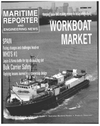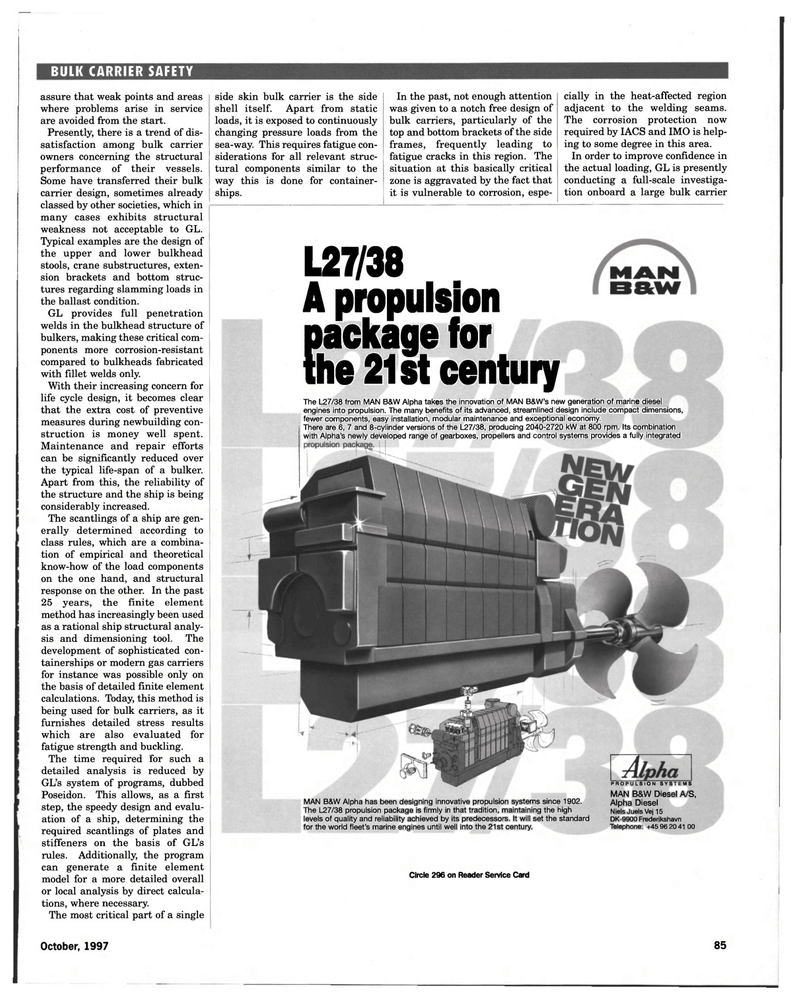
Page 75: of Maritime Reporter Magazine (October 1997)
Read this page in Pdf, Flash or Html5 edition of October 1997 Maritime Reporter Magazine
BULK CARRIER SAFETY assure that weak points and areas where problems arise in service are avoided from the start.
Presently, there is a trend of dis- satisfaction among bulk carrier owners concerning the structural performance of their vessels.
Some have transferred their bulk carrier design, sometimes already classed by other societies, which in many cases exhibits structural weakness not acceptable to GL.
Typical examples are the design of the upper and lower bulkhead stools, crane substructures, exten- sion brackets and bottom struc- tures regarding slamming loads in the ballast condition.
GL provides full penetration welds in the bulkhead structure of bulkers, making these critical com- ponents more corrosion-resistant compared to bulkheads fabricated with fillet welds only.
With their increasing concern for life cycle design, it becomes clear that the extra cost of preventive measures during newbuilding con- struction is money well spent.
Maintenance and repair efforts can be significantly reduced over the typical life-span of a bulker.
Apart from this, the reliability of the structure and the ship is being considerably increased.
The scantlings of a ship are gen- erally determined according to class rules, which are a combina- tion of empirical and theoretical know-how of the load components on the one hand, and structural response on the other. In the past 25 years, the finite element method has increasingly been used as a rational ship structural analy- sis and dimensioning tool. The development of sophisticated con- tainerships or modern gas carriers for instance was possible only on the basis of detailed finite element calculations. Today, this method is being used for bulk carriers, as it furnishes detailed stress results which are also evaluated for fatigue strength and buckling.
The time required for such a detailed analysis is reduced by
GL's system of programs, dubbed
Poseidon. This allows, as a first step, the speedy design and evalu- ation of a ship, determining the required scantlings of plates and stiffeners on the basis of GL's rules. Additionally, the program can generate a finite element model for a more detailed overall or local analysis by direct calcula- tions, where necessary.
The most critical part of a single side skin bulk carrier is the side shell itself. Apart from static loads, it is exposed to continuously changing pressure loads from the sea-way. This requires fatigue con- siderations for all relevant struc- tural components similar to the way this is done for container- ships.
In the past, not enough attention was given to a notch free design of bulk carriers, particularly of the top and bottom brackets of the side frames, frequently leading to fatigue cracks in this region. The situation at this basically critical zone is aggravated by the fact that it is vulnerable to corrosion, espe- cially in the heat-affected region adjacent to the welding seams.
The corrosion protection now required by IACS and IMO is help- ing to some degree in this area.
In order to improve confidence in the actual loading, GL is presently conducting a full-scale investiga- tion onboard a large bulk carrier
L27/38 A propulsion package for the 21st century
The L27/38 from MAN B&W Alpha takes the innovation of MAN B&W's new generation of marine diesel engines into propulsion. The many benefits of its advanced, streamlined design include compact dimensions, fewer components, easy installation, modular maintenance and exceptional economy.
There are 6, 7 and 8-cylinder versions of the L27/38, producing 2040-2720 kW at 800 rpm. Its combination with Alpha's newly developed range of gearboxes, propellers and control systems provides a fully integrated
MAN B&W Alpha has been designing innovative propulsion systems since 1902.
The L27/38 propulsion package is firmly in that tradition, maintaining the high levels of quality and reliability achieved by its predecessors. It will set the standard for the world fleet's marine engines until well into the 21st century.
Circle 296 on Reader Service Card
PROPULSION SYSTEMS
MAN B&W Diesel A/S,
Alpha Diesel
Niels Juels Ve) 15
DK-9900 Frederikshavn
Telephone: +45 96 20 41 00
October, 1997 85

 74
74

 76
76
